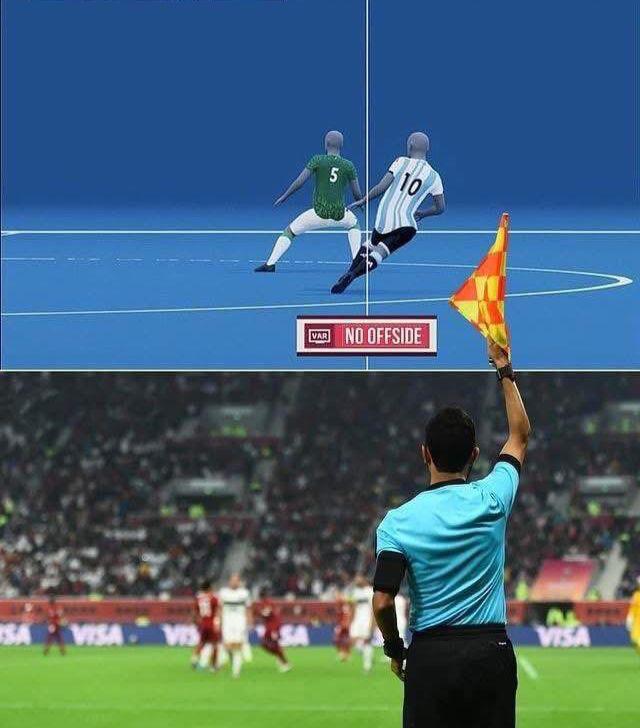Football is played on every continent, in every country and at different levels. Football rules are universal, they are understood and applied across various levels, ranging from the FIFA World Cup to matches by young children on the streets. It is common place in the game for new rules to be enacted.
Football rules keep the “round-leather game” fair and simple, with players expected to respect each other, the match officials and the laws.
The International Football Association Board (IFAB) which oversees the laws of football constantly changes the rules; to ensure soccer remains attractive and enjoyable for players, match officials and coaches, as well as fans, administrators and stakeholders.
FootballOrbit brings you the following changes to football rules in 2025/26.
The eight-second rule
Last season, trials were conducted to deal more effectively with goalkeepers who waste time by holding on to the ball for too long.
Consequently, a new rule is now in place, stating that goalkeepers will be penalised if they hold the ball for more than eight seconds. A corner kick will be awarded to the opposition in such cases.
Before, the duration was six seconds, with the punishment being an indirect free kick.
However, it was rarely enforced. But the newly introduced rule will be strictly adhered to.
Guidelines
A goalkeeper is considered to be in control of the ball with their hand(s)/arm(s) when:
• The ball is between their hands/arms or between their hand(s)/arm(s) and any surface (e.g. ground, own body).
• Holding the ball in their outstretched open hand(s).
• Bouncing it on the ground or throwing it in the air.
Besides, the goalkeeper cannot be challenged by an opponent when in control of the ball with their hand(s)/arm(s).
Moreover, the referee will decide when the goalkeeper has control of the ball and the eight seconds begin, and will visually count down the last five seconds with a raised hand.
When a goalkeeper exceeds the eight seconds countdown, the referee will award a corner kick (rather than a indirect free kick), on the side of the field closest to the goalkeeper’s position when penalised.
Also, the goalkeeper will not be booked for such offence, unless if done repeatedly.
Captains-only referee interactions

Respect and fairness are core values of football, but referees and other match officials are regularly subjected to verbal and/or physical dissent when they make decisions.
In extreme cases, players sometimes run at referees and surround or mob them, trying to influence their decisions.
This is not only provocative and intimidating for match officials, it also harms the overall image of the “beautiful game”.
The new captains-only rule now limits on-field communications to just between the referee and the team captains.
In this regard, so that the referee can explain key decisions, only the captains are allowed to approach the referee, and must conduct themselves respectfully.
Likewise, it is the responsibility of each captain to ensure that their team-mates remain a reasonable distance from the referee, and do not interfere in the interaction between the referee and the team captain(s).
Guidelines
• Normal interactions between players and the referee are allowed and remain important (to promote transparency and avoid possible frustration and conflict).
• Any player (including the captain) who shows dissent by word or action will be cautioned (yellow card).
• The referee will, where appropriate, explain important decisions to the captain(s) and/or the player(s) involved in an incident.
• Interaction with, or an approach by, any player other than the captain is at the discretion of the referee, e.g. if the player has committed an offence, been fouled and/or is injured.
When the captain is the goalkeeper
• Where the goalkeeper is the captain, the referee must be told, no later than at the coin toss before kick-off, which player is nominated to approach the referee instead of the goalkeeper.
• Only the goalkeeper or the nominated player, not both, may approach the referee.
• If the nominated player is substituted or sent off, another player must be nominated.
The hope is that this captains-only approach will improve player behaviour, while mass confrontations and surrounding the match officials will reduce.
Double-kick penalties can be retaken
If a penalty taker accidentally touches the ball twice during their run-up and the ball goes in, the penalty will be retaken instead of the goal being disallowed.
However, a deliberate double-touch will see an indirect free-kick awarded to the defending team.
A controversial incident involved Atletico Madrid forward Julian Alvarez last season. He slipped as he took a penalty in a Champions League shootout against Real Madrid with the ball making slight contact with his standing leg.
The goal was not given, Alvarez was not allowed a retake, and Atletico lost the shootout and got eliminated.
Holding in the penalty box
Grappling or holding an opponent in the penalty area is a foul that will result in a penalty kick if the offense affects the opponent’s movement and their ability to play the ball — especially from a set piece like a corner or free kick.
Referees and VARs will take note of whether the holding player’s focus is on the ball or the opponent.
Dropped ball
Prior to drop ball situations, there are times when the ball would clearly have gone to an opponent of the team that last touched the ball.
The new rule clarifies that it is fairer for the ball to be dropped for the team that would have gained possession, as long as this is clear to the referee.
Also, if it is outside the penalty area, the ball will now be dropped at its position when play was stopped.
Procedure
If, when play was stopped:
- The ball was inside the penalty area, the referee drops it for the defending team goalkeeper in their penalty area.
- The ball was outside the penalty area, the referee drops it for one player of the team that has or would have gained possession if this can be determined by the referee.
Otherwise, it is dropped for one player of the team that last touched it. The ball is dropped at its position when play was stopped.
• All other players (of both teams) must remain at least 4 m (4.5 yds) from the ball until it is in play.
The ball is considered in play when it touches the ground.
The ball is dropped again if it:
• Touches a player before it touches the ground.
• Leaves the field of play after it touches the ground, without touching a player.
If a dropped ball enters the goal without touching at least two players, play is restarted with:
• A goal kick if it enters the opponents’ goal.
• A corner kick if it enters the team’s goal.
Interference with the ball when going out of play
If, without intending to interfere with play unfairly, a team official, substitute, substituted or sent-off player or player who is temporarily off the field of play (injury, adjusting equipment etc.) touches the ball while it is still in play, but when it is clearly leaving the field of play, with the intention of helping the game restart quickly, this is penalised with an indirect free kick.
There is no booking, unless for an individual persistently leaving the technical area.
Guidelines
If the interference was by:
• A team official, substitute, substituted or sent-off player, play restarts with a direct free kick or penalty kick.
• An outside agent, play restarts with a dropped ball.
However, if a ball is going into the goal and the interference does not prevent a defending player playing the ball, the goal is awarded if the ball enters the goal (even if contact was made with the ball), unless the interference was by the attacking team.
Offside point of contact rule
The adjustment to the offside rule is that, in general play, the first point of contact with the ball is used when determining whether a player is in an offside position.
However, when the ball is thrown by the goalkeeper, the last point of contact should be used, as this provides a clearer and more consistent reference point.
Guidelines
• General play: When a player is passing or touching the ball to a teammate, the point of the body or foot that makes the first contact with the ball is used to determine if the player receiving the pass is in an offside position.
• Goalkeeper’s throw: If a goalkeeper makes a throw to a teammate, the point of contact where the ball was last touched before it was thrown is used to assess the offside position of the receiving player.
This rule came to limelight after a Swedish club, Torns IF, identified a loophole in the offside rule in a scenario where a player could “balance” a ball on their foot, creating a first point of contact, and then move beyond the defenders to receive the ball from that same play — which could technically keep them onside.
Subsequently, IFAB reviewed the situation and clarified the wording in the offside law for the 2025/26 season to specifically address this “delayed” pass scenario, which is now captured by the change in the rule regarding the goalkeeper’s throw.
This change ensures that the spirit of the offside rule is maintained, preventing such a loophole from being exploited in matches.
Referee announcements
After successful trials last season, football competitions now have the option of the
referee announcing and explaining the final decision after a Video Assistant Referee (VAR) review.
This will further clarify referee decisions to players, crew and fans, thereby, eliminating/reducing controversies.
Referee Body Cameras
Another new football rule makes it permissible for referees to wear cameras (Ref Cams) in their earpieces to provide a unique and unprecedented live view of actions to audiences from referees’ perspective.
Assistant referees’ positioning at penalty kicks
At a penalty kick, the assistant referee will remain on the touchline and take a position in line with the penalty mark.
The VAR will now be solely responsible for monitoring any goalkeeper encroachment at the taking of a penalty kick
The assistant referee must be positioned at the intersection of the goal line and the penalty area (which is the offside line), as being on the goal line creates a risk that they may not be able to get back into a position to judge offside if the kick rebounds.
Concussion rules
Although injuries are part of the game, football rules must also contribute to the safety and welfare of players, hence, appropriate regulations should regularly be made to such effect.
Therefore, football bodies have the option of allowing the use of “additional permanent concussion substitutions”. This enables teams to prioritise the welfare of a player who has an actual or suspected concussion without suffering a numerical disadvantage.
An additional permanent concussion substitution will be used when a player who has an actual or suspected concussion is substituted and takes no further part in the match. This substitution does not count as one of the “normal” permitted substitutions.
Guidelines
• Each team is permitted to use a maximum of one “concussion substitute” in a match.
• A “concussion substitution” may be made regardless of the number of substitutes already used.
• In competitions in which the number of named substitutes is the same as the maximum number of “normal” substitutes that can be used, the “concussion substitute” can be a player who has previously been substituted and may be used at any time, regardless of the number of substitutes already used.
• When a “concussion substitute” is used, the opposing team then has the option to use an “additional substitute” for any reason.
Conclusion
National Football Associations have the option to approve any of the new football rules for different competitions – there is no requirement to apply them universally or to apply them all.
However, no other modifications are allowed without the permission of IFAB.
Some of the new rules were used at the 2025 FIFA Club World Cup, and the UEFA U-21 Euros.
Also, the English Premier League has already implemented these new rules for the 2025/26 season.



